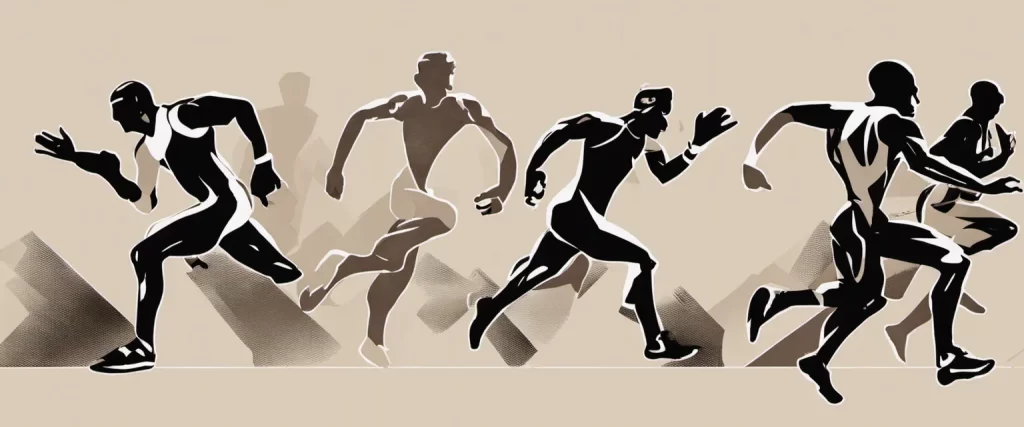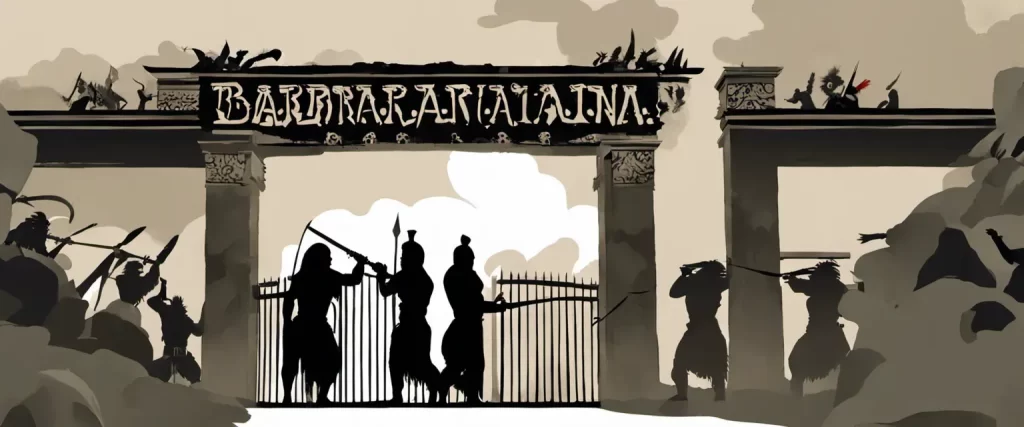——Barbarians at the Gate by Bryan Burrough & Sprint by Jake Knapp
In the realm of business literature, numerous books have been penned to unravel the intricate workings of corporate culture, strategy, and decision-making processes. Among these, two remarkable literary works stand out: “Barbarians at the Gate” by Bryan Burrough and “Sprint” by Jake Knapp. Poles apart in their subject matter and approach, these books provide unique insights into the worlds of high-stakes finance and innovative product development, respectively. In this comparative study, we delve deep into the narratives of these two captivating works, aiming to examine their divergent perspectives on the challenges faced by organizations in today’s rapidly evolving landscape.
Written by Bryan Burrough, “Barbarians at the Gate” is a gripping narrative that delivers an unfiltered account of one of the most notorious corporate takeovers in history – the battle for RJR Nabisco in the late 1980s. Burrough, a skilled journalist and writer, carefully traces the series of events leading up to this extraordinary deal, detailing the intricate power struggles, financial maneuvers, and human dramas that unfolded within the company’s boardrooms. Exploring the theme of gluttonous greed and the underlying mechanisms of Wall Street, Burrough shines a light on the machiavellian tactics employed by key players during this astonishing saga.
On the other hand, “Sprint,” authored by Jake Knapp, takes a distinctly different approach as it focuses on optimizing the creative and problem-solving processes within organizations. A former Google Ventures design partner, Knapp introduces readers to the concept of a “design sprint,” a time-constrained framework that aims to bring together cross-functional teams to tackle complex challenges and rapidly prototype solutions. Through vivid storytelling and practical guidance, Knapp showcases how companies can leverage these design sprints to foster innovation, align teams, and ultimately, deliver remarkable products and services to the market.
Despite their contrasting subject matter, Bryan Burrough and Jake Knapp share a common goal: to dissect the inner workings of organizations and shed light on the motivations, actions, and consequences that shape their trajectories. As we embark on this comparative exploration, we will analyze the strategic choices made by both authors, evaluate their writing styles, and assess the effectiveness of their narratives in uncovering the complexity of the corporate world. By bringing together these two distinct perspectives, we strive to gain a more comprehensive understanding of the challenges faced by organizations, enabling us to glean essential lessons applicable to today’s ever-changing business landscape.
Brief Summary of Two Books
Barbarians at the Gate by Bryan Burrough
“Barbarians at the Gate: The Fall of RJR Nabisco” by Bryan Burrough is an in-depth and captivating account of the leveraged buyout (LBO) battle that took place in the late 1980s for the control of RJR Nabisco, a prominent American conglomerate. The book presents a detailed narrative of the high-stake corporate takeover and the players involved.
The story begins with the ambitious CEO of RJR Nabisco, F. Ross Johnson, who envisions a management buyout of the company. Johnson, along with his top executives, decides to take the company private by leveraging a massive amount of debt. However, this attracts the attention of several powerful Wall Street firms and investors who see an opportunity to challenge Johnson’s bid.
Burrough delves into the intricacies of the epic battle between Johnson and a consortium led by Henry Kravis and his firm, Kohlberg Kravis Roberts (KKR). The author exposes the ruthless tactics employed by both sides, including aggressive bidding, propaganda campaigns, and exploiting legal loopholes. The book also highlights the intense rivalry between Johnson and Kravis, who represent opposing approaches to corporate management.
Amidst the backdrop of a booming 1980s corporate culture infused with excesses, Burrough explores how the factions involved in the takeover attempt to outmaneuver each other. The book provides insights into the world of investment banking, private equity, and the financial strategies deployed during LBOs, as well as exposing the greed and ego behind the scenes.
“Barbarians at the Gate” offers readers an exciting and entertaining portrayal of the events leading up to the ultimate outcome of the RJR Nabisco battle. It unravels the complex politics and financial maneuvers involved in corporate takeovers and sheds light on the consequences of excessive debt incurred during massive LBOs. Overall, the book is an engrossing narrative that captures the drama and intrigue behind one of the most significant business deals in history.
Sprint by Jake Knapp
Sprint: How to Solve Big Problems and Test New Ideas in Just Five Days, written by Jake Knapp, is a step-by-step guide on utilizing a five-day process known as a “Design Sprint.” This sprint is a framework designed to help teams answer critical business questions through user feedback and rapid prototyping.
The book provides a detailed explanation of how the Design Sprint works, offering practical advice, real-life examples, and success stories from various companies like Google Ventures. The Design Sprint aims to compress months of work into just five days, allowing teams to efficiently test ideas, validate assumptions, and make decisions based on real user feedback.
Knapp breaks the Design Sprint down into five distinct phases: Understand, Sketch, Decide, Prototype, and Test. He provides clear instructions, checklists, and tips to help readers implement each phase effectively. The book also emphasizes the importance of a diverse team and clear roles during the sprint process.
The author discusses common challenges teams may encounter during the sprint and provides suggestions for overcoming them. He addresses potential roadblocks in implementing the sprint within organizations and offers strategies to navigate these obstacles successfully.
Overall, Sprint offers a concise, actionable guide for teams looking to accelerate their problem-solving process and deliver innovative products or solutions. It presents a proven methodology for answering critical business questions, reducing risk, and achieving faster results through collaboration and user feedback.
Comparison between Two Books

Similarities in business strategy
Barbarians at the Gate by Bryan Burrough and Sprint by Jake Knapp offer valuable insights into the business world and its strategies. Despite being set in different industries and contexts, there are some similarities in their approach to business strategy:
1. Focus on Collaboration: Both books emphasize the significance of collaboration within organizations. Barbarians at the Gate explores the intense negotiations and teamwork required during the leveraged buyout of RJR Nabisco, highlighting how different departments and team members came together to achieve a collective goal. Similarly, Sprint advocates for cross-functional collaboration and the use of diverse perspectives during the process of building a new product or service.
2. Strategic Planning: Both books recognize the importance of strategic planning. Barbarians at the Gate delves into the strategic decisions made by the management and executives at RJR Nabisco, as well as the private equity firms involved, to pursue and navigate the leveraged buyout. Sprint highlights the significance of a structured and thoughtful approach to product development through its step-by-step process known as a “design sprint.”
3. Financial Considerations: Both books acknowledge the critical role of financial considerations in business strategy. Barbarians at the Gate highlights the financial intricacies involved in the leveraged buyout, including negotiations on stock prices, debt financing, and the assessment of company valuation. Sprint also emphasizes the need for financial viability during the product development phase and encourages entrepreneurs to test their ideas using realistic metrics.
4. Competitive Landscape: Both books shed light on the analysis of competitive landscapes. Barbarians at the Gate explores the fierce competition between rival bidders during the acquisition process, showcasing the strategies employed by these bidders to gain an advantage. Sprint encourages businesses to conduct competitor analysis and understand market dynamics during the product development process, ensuring that their offerings address customer needs and stay ahead of competition.
5. Adaptability and Flexibility: Both books highlight the need for adaptability and flexibility in business strategy. Barbarians at the Gate shows how the bidding groups had to modify their strategies and adapt to changing circumstances throughout the leveraged buyout process. Sprint advocates for conducting frequent experiments and usability tests to learn from customer feedback and make necessary adjustments to the product.
While Barbarians at the Gate focuses on a historical event and Sprint provides a design framework, both books share similarities in terms of emphasizing collaboration, strategic planning, financial considerations, analyzing competitive landscapes, and embracing adaptability and flexibility.
Divergences in business strategy
“Barbarians at the Gate” by Bryan Burrough and “Sprint” by Jake Knapp are both books that focus on business strategies but differ significantly in their approaches and subject matter.
Firstly, “Barbarians at the Gate” delves into the world of high-stakes corporate deals and the complex process of leveraged buyouts. It tells the gripping story of the acquisition of RJR Nabisco, one of the largest leveraged buyouts in history. The book focuses on the intense rivalries, power struggles, and financial maneuvering involved in this business transaction. It offers a detailed and in-depth analysis of the various tactics employed by different parties to outmaneuver each other and gain a competitive advantage.
On the other hand, “Sprint” takes a different perspective by presenting a step-by-step guide for solving big startup problems within five days. This book introduces the concept of a “design sprint,” a time-boxed process aimed at rapidly solving critical business challenges and generating innovative ideas. It provides practical techniques and tools for teams to collaborate effectively and quickly make decisions.
In terms of divergence in business strategy, “Barbarians at the Gate” focuses more on traditional business practices such as deal-making, financial engineering, and market competition. It explores how companies strategize to gain a competitive edge through negotiations, tactics, and leveraging financial resources. The book highlights the importance of understanding market dynamics and corporate finance to succeed in the highly competitive business landscape.
Meanwhile, “Sprint” introduces a more modern and agile approach to business strategy. It emphasizes the importance of collaboration, rapid prototyping, user feedback, and time-bound decision-making. This book encourages an iterative process of developing and testing ideas with a user-centric approach, helping teams to find innovative solutions to complex problems efficiently. The focus lies on the lean startup methodology and the need for continual adaptation and improvement.
In summary, while both books discuss business strategies, “Barbarians at the Gate” concentrates on the intricate world of corporate deals and financial engineering, while “Sprint” offers a practical framework for rapid problem-solving and innovation in the startup environment. These divergent approaches reflect the difference in subject matter and context, with one focusing on historical corporate events and the other providing a contemporary guide for startups seeking innovation and efficiency.

Conclusion
Both “Barbarians at the Gate” by Bryan Burrough and “Sprint” by Jake Knapp are well-regarded books in their respective genres. It ultimately depends on your personal interests and what you are looking to gain from reading.
“Barbarians at the Gate” is a non-fiction book that tells the gripping story of the leveraged buyout (LBO) of RJR Nabisco, one of the largest takeovers in American corporate history. It provides an in-depth look into the competitive world of mergers and acquisitions, giving readers a behind-the-scenes narrative of the greed, power struggles, and financial intricacies involved. If you have an interest in finance, business, or history, this book offers a captivating and educational read.
On the other hand, “Sprint” is a practical guide for teams looking to solve big problems and test new ideas in just five days. The book introduces a framework called the “design sprint,” which is a five-day process for brainstorming, prototyping, and testing ideas with customers. It is especially valuable for individuals involved in product development, innovation, or entrepreneurship as it provides a structured approach to rapidly solving problems and validating ideas.
In conclusion, if you are interested in finance, business history, and want an engaging narrative, “Barbarians at the Gate” might be the better choice for you. However, if you are looking for practical techniques to drive innovation, problem-solving, or product development, “Sprint” could be the more worthwhile read.



